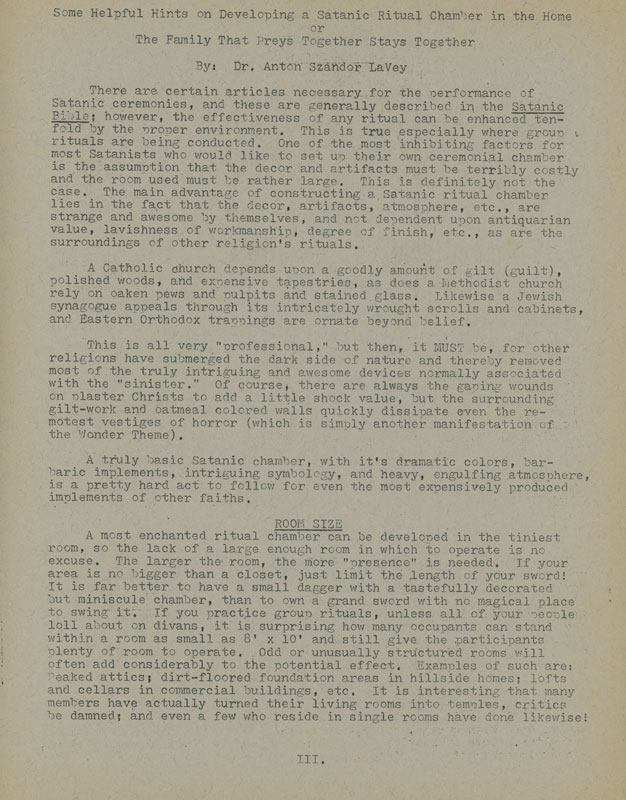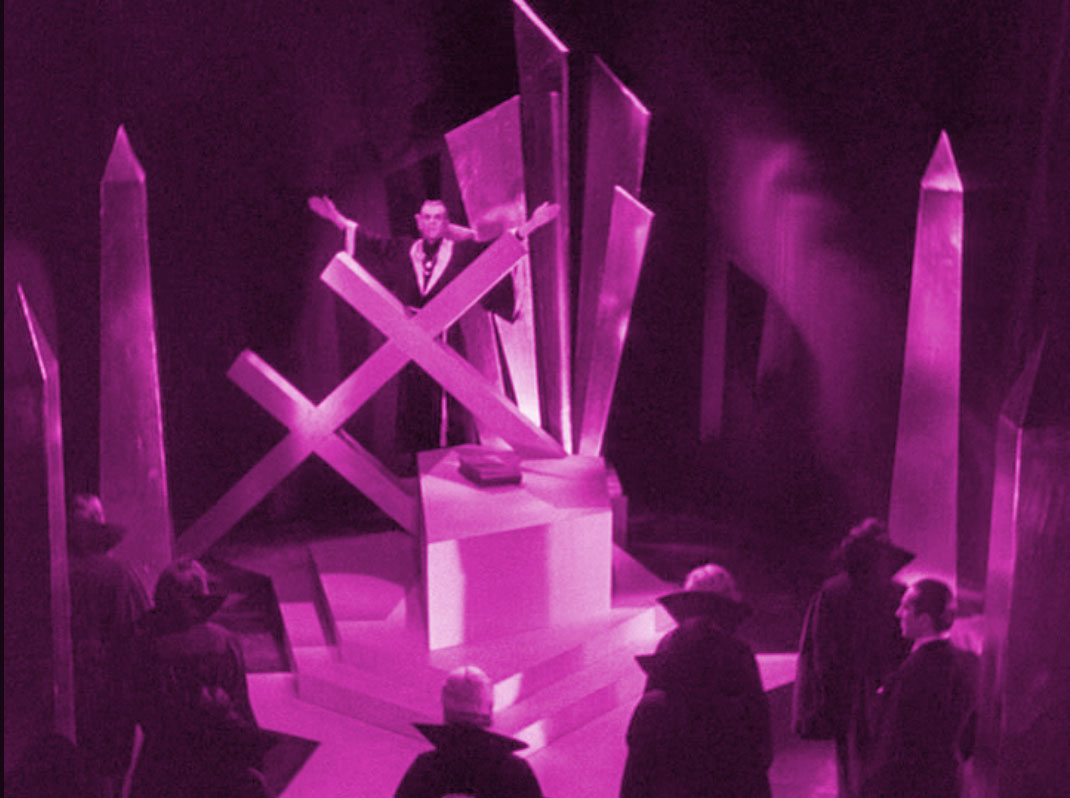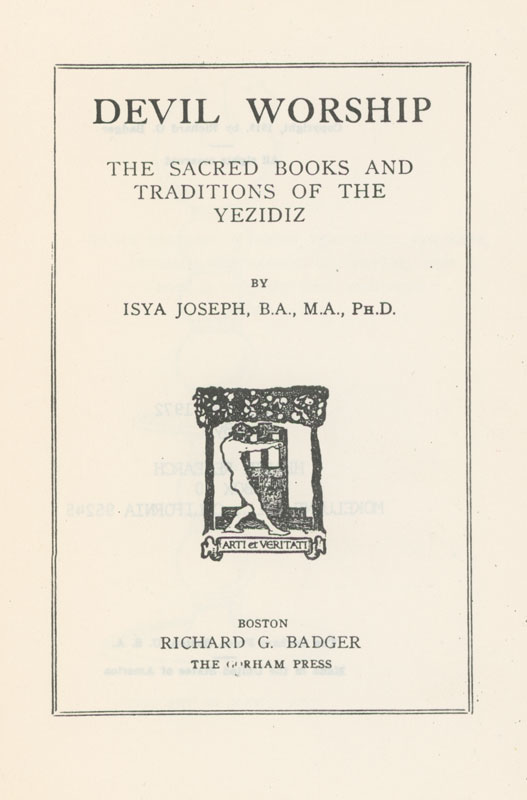

The Rite Stuff: Anton LaVey’s The Satanic Rituals
by Magus Peter H. Gilmore
When Anton LaVey founded the Church of Satan on April 30, 1966, one of his primary reasons for casting his skeptical, atheist, materialist philosophy as a religion was his understanding that humans are naturally attuned to ritualistic behavior, which is integral to most of the world’s faiths. Symbols, metaphor, gestures and pageantry are essential activities for the beasts called Mankind. Rituals enhance productivity, offer solace, create focus, and most importantly assist as potent means towards catharsis of emotional states that might linger and hinder one from moving towards one’s chosen goals. When joining the early Church of Satan, the newly self-defined Satanist could send for instructions on how to perform Satanic Rituals—only $5.00! These became a bit more refined when they were included in The Satanic Bible, published in December of 1969.

From the order sheet:
If you as a Satanist wish to practice the rituals of Satanism, either in a group or privately, here is your opportunity. Now that you have chosen the Path of Darkness as a tangible means to your goals, you may want to gain your desires by using the forces of ceremonial magic, which are now at your disposal. Solve your own problems without waiting for “God’s help,” or an unpredictable stroke of “fate.” The instructions that have been prepared for performing Satanic ritual are available only to members of the Satanic Church.
…If you really want power to overcome obstacles, and the thought of “blasphemy” does not scare you off, THIS IS YOUR CHANCE TO PRACTICE THE BRAND OF MAGIC THAT HAS BROUGHT SUCCESS TO EVERY TRUE WITCH OR WIZARD THE WORLD HAS EVER KNOWN!

As you can see, the purpose for these rites is not worship, but to pro-actively attain desired goals—and those could be as base as one might desire: for our lust to be satisfied, for our enemies to be destroyed, for health and well-being for those we may cherish—and for ourselves as well!
As any student of the history of Dr. LaVey and the Church of Satan knows, its rituals became a primary focus for every article, and later films, exploring this new and controversial atheism-based religion. Because LaVey used a nude female altar—and of course would have no problem should homophile Satanists use a nude male—that blatant carnal aspect of Satanism made it a sensation, as well as a staple for articles appearing in “men’s magazines,” copiously illustrated with photos of nude females on the altar and serving as acolytes. LaVey was a capable showman and knew how to publicize his fledgling philosophy, but these ceremonies were not just window dressing for publicity: LaVey considered them integral if one wished to explore practical aspects of applied psychology as offered in his down-to-earth philosophy.
With the success of The Satanic Bible, which offered the basics of ritual as developed from the instructions sent to early members, and the placing of The Compleat Witch with a different publisher, LaVey and his editor at Avon decided that those titillating rituals glimpsed in the photoshoots and in the documentary film SATANIS: THE DEVIL’S MASS might be of interest to those who enjoyed The Satanic Bible and wanted more. LaVey had been performing varied dark rites for his local congregants in his Black House every Friday night—the admission fees had been a part of his income, supplementing his lectures, organ playing and freelance photography, as well as his “ghost busting” investigations. It seemed sensible to publish these rituals in a companion book, so LaVey selected several that had been “ritual chamber tested”—though he left out others as likely being a bit too obscure for a general audience seeking dark-themed esoterica. One of these was The Madness of Andelsprutz, a psychodrama in which participants take on the roles of people whom they find threatening to “exorcize” themselves of fear through mockery. It was not particularly “occult” in its tone and so it was excluded.

For Anton LaVey, film was an eloquent repository of dreams and nightmares. It directly invoked fantasy and stylized reality to ensorcel those who participated in its magic lantern shows—always in darkened chambers, of course, a ritual embraced by many with gusto. Karloff and Lugosi teamed up for Ulmer’s THE BLACK CAT, in which Karloff as Hjalmar Poelzig, a “high priest of Satanism,” met with an old adversary, Lugosi, in an Art Deco mansion of his own brilliant design. Karloff is seen doing some bedtime reading, a book titled THE RITES OF LUCIFER, hence Magus LaVey chose to insert a page at the beginning of his compendium of sinister ceremonies with that very title. The cognoscenti caught the reference; the innocent found it exciting.
Since Satanism advocated self-identifying with Satan and various other blasphemous devil figures from many cultures, it was essential that the rituals presented had diversity, as LaVey contended that his perspective was derived from numerous cultures. The list of Infernal Names in The Satanic Bible, and the earlier ritual instructions, was already international and cross-cultural in scope. He decided to present a traditional Messe Noir—any book about Satanic Ritual without that would have disappointed purchasers. With a text inspired by Huysmans novel Là-Bas, the long French history of obsession with diabolism was given tribute. And, saluting Taxil’s hoax which launched the “Palladian Panic” that trolled Freemasonry as being a diabolical pursuit, LaVey included a Templar-themed rite, L’Air Epais. From Germany, the fount of eerie expressionist cinema which explored the dark interstices of human feelings, LaVey presented two ceremonies with cinematic inspiration. THE ISLAND OF LOST SOULS sourced Das Tierdrama and the METROPOLIS-inspired Die elektrischen Vorspiele. Western audiences have long been intrigued by the exoticism of folk tales from The Arabian Nights, and LaVey had discovered that there was a sect of supposed “Devil Worshippers” in the Middle East. Thus, Isya Joseph’s DEVIL WORSHIP, The Sacred books and Traditions of the Yezidiz was purposed for a meditative piece—and how apt was it that the peacock, an avian symbol of pride—an essential to Satanists, was embodied in Melek Tâ’ûs. The Homage to Tchort was inspired by Disney’s boldly rendered Chernabog from FANTASIA, which had lead LaVey to seek out the Russian mythology which inspired Mussorgsky’s infernal tone poem.

Magus LaVey was an aficionado of H.P. Lovecraft’s tales of cosmic dread, and he had been a friend of Clark Ashton Smith—one of the Old Gent’s literary circle. Smith’s The Weird of Avoosl Wuthoqquan loosely inspired a ritual for personal success, The Ceremony of the Avoosal, which included a large spider figure ensconced in a web who was depicted as being a guardian of a treasure trove whose beneficence one sought. With the procuring of a suitable giant spider figure then being not only difficult, but possibly limited to being comical, LaVey chose not to include it. These days, there are plenty of Halloween stores vending menacing gigantic arachnids, as well as suitable webbing, so it may be time to revive that one for retro fun. LaVey tasked Michael A. Aquino, then the editor of The Cloven Hoof newsletter, to try his hand at a couple of rituals using Lovecraftian imagery. Aquino crafted both The Ceremony of the Nine Angles and The Call to Cthulhu, to which LaVey made some minor tweaks and provided an introduction. Aquino’s incipient theism flowered into a strong belief in supernatural intelligences, so he soon departed the Church of Satan to found his Temple of Set in 1975.
While LaVey did not conceive of the Church of Satan as being an initiatory organization, people who had been members of more conventional churches often felt the need for a “baptism,” so LaVey reworked the ritual he had used for his daughter Zeena that had been given ample press coverage when it was performed in 1967. Today, most Satanists find baptism unnecessary; they come to the Church of Satan feeling they’ve been Satanists since birth and thus do not need to enact a rejection of spiritual doctrines, as they’ve never embraced them in the first place. They find Satanism as a label for their true nature, not as a fresh pathway away from earlier, unsatisfying belief systems.
The very essence of Satanism is individualism, so the rituals provided in both The Satanic Bible and The Satanic Rituals are suggested frameworks, always meant to be open for a Satanist to adapt to satisfy personal emotional and aesthetic needs. These are not dogmatic liturgies which must be performed with precision, but LaVey felt that those making amendments should employ their best sense of the dramatic to evolve these texts for personal use. Since Magus LaVey’s passing, I’ve presided at numerous newly-composed dark rites in evocative locations: an impromptu ritual in a lava tube under Mt. St. Helens, a celebration of Anglo-American diabolism in Dashwood’s Hellfire Caves, a “Satanic High Mass” at an atheist center in Los Angeles which referenced both the text and design of Herr Poelzig’s Luciferian ceremony, and several intriguing rites of dedication, health and prosperity here in the ritual chamber of my Black House in the Hudson Valley. All of these were moving experiences and ranged from intricate hieratic formalities to improvised, passionate pronouncements.
For those of you who embrace the philosophy of Satanism, but who have not been inclined to the practice of Greater Magic, I suggest that you might find it worthwhile to explore this enriching activity. Humans use ritual to key into aspects of their deeper consciousness, from birthday celebrations to participatory acts at concerts, sports events, or other varied testimonials and memorials that have public expression. If one can find personal significance for such, ritual can be life-enhancing. Satanic Ritual is not a passive spectator affair—it is active, dynamic, and requires participation. Unlike so many worship services performed by spiritual religions, in Satanism one is not just an onlooker, but a vital part of the proceedings. If someone is a bit shy, solitary ritual serves well as a means for centering one’s grasp of personal desires, strengths, and any shortcomings that must be identified and overcome. Group ritual can be invigorating—though one must always select fellow participants with the greatest of care as they need add to the event, not simply witness it, or otherwise detract from the unity of purpose that energizes your chamber. In Satanic Ritual, you want allies, not an audience.
I’m certain you’ll enjoy the panoply of deviltry herein that comes from historic traditions as well as past fictions. May you be inspired to create your own rites from sources you find exciting. While using one’s native language has the advantage of clarity, the use of arcane languages can be powerful. Latin and Enochian can stand beside the more recent Klingon, Sith, Quenya, Khuzdûl or the Black Speech, if such tongues ignite your passions. Employ imagery from fictions that touch you deeply, whether they arise from history, myth, sci-fi, horror or fantasy realms. If these evocative fantasies haunt your thoughts and take you to domains of imagination that fulfill your fixations, then embrace them as fuel for your fervid conjurations. Anton LaVey here proffers formidable methodologies—let them ignite your visions and lead to your ever-deepening satisfaction as you move the world according to your will!
—Magus Peter H. Gilmore
The Black House, 13 January, LV A.S.

Portrait

Peter H. Gilmore
High Priest of the Church of Satan
We Are Legion
A Moment In Time
This slideshow requires JavaScript.
SUPPORT THE
CHURCH OF SATAN!
There are many ways you can support the Church of Satan. Visit our support page to learn how.
navigation-topper


